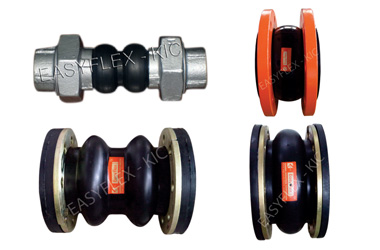Expansion Joints or Compensators are flexible rubber elements (combined with metal and/or textile reinforcements) useful for conveying fluids and absorbing movements between sections or pipeline. With a correct design, they are able to absorb axial, lateral and angular movements offering both safety and insulation against noise and vibrations. We offer the market the most comprehensive selection of rubber expansion joints, covering the widest range of applications and dimension. By adopting the latest rubber and fabric technology, SKG Pneumatics Inc can provide the most effective solutions to suit the required needs for any pipe systems.
Outstanding Advantages
- Variety of polymers available
- Internationally approved design as per FSA and EJMA USA
- Positive sealing for leak free operation
- Eliminates line noise
- Compensates for misalignment-axial, lateral, angular torsional
- Absorbs vibration & shock
- Eliminates stress or expansion & contraction
- Prevents electrolytic corrosion
- Prevents pipe buckling & fracture
- Stops water hammer
- Abrasion, water, heat, chemical, weather resistant
- Resistant to fatigue
- Greater recovery from the movement
- Low deformation under pressure
- Negligible loss of heat
Wide Range: Standard Size Available Ex-Stock
How A Rubber Expansion Joint works
The purpose of an Expansion Joint in general, regardless of design or materials of construction, is to provide a point of flexibility in a piping or duct system in order to absorb the growth of the piping due to thermal changes in the media and/or the environment and to absorb the dynamic movements of machinery, buildings and structures that the piping is attached to or a part of. The Rubber Expansion Joint, because of the nonmetallic nature of its construction, offers the piping and ductwork designer advantages within the temperature and pressure ranges of these joints, which cannot be matched by all-metal expansion joints.
Consisting of flanged ends and a flexible section, much the same as a flanged metal bellows, rubber expansion joint can absorb within its free length more movements, particularly lateral, than any other joint of similar overall size and pressure rating. The flexible section of a Rubber Expansion Joints is most often a single convolution, which, because of the inherent flexibility of the materials, can accept large lateral movements with low force, phenomena which require multiple convolutions in metal bellows. During axial and angular movements, the rubber convolution deflects much the same way that the metal convolution does.
The limits of these motions are determined by the geometric shape and size of the convolution and the inherent pressure resisting capacity of the design. The manner in which the pressure loads are resisted in a Rubber Expansion Joint is the major difference between Rubber and Metal Bellows. Circumferential (hoop) loads due to pressure are carried by the convolution itself in metallic bellows. In a Rubber Expansion Joint, the convolution is basically incapable of resisting pressure by itself but is supported by the adjacent rubber tube with its internal fabric and/or fabric – metal reinforcing, or by the attachment flanges themselves.
All Easyflex Units have integrally molded flanges, sized and drilled to match standard flanges. All Rubber Expansion Joints require metallic split retaining rings behind the flanges to back up protect the rubber integral flange. Control rods must be used to protect expansion joints from excessive movement if the piping system is not properly anchored and are normally recommended for most piping installations.
Single Arch Expansion Joints
- Greater Movements.
- Higher Pressure Ratings.
- No gaskets required.
- Absorbs & Isolates Vibrations/Noise/Shock.
- Molded Design for better quality up to size 14″ NB.
- Reduces System Noise.
- Absorbs Pipe Movement/Stress.
- Compensates for Misalignment/Offset.
- Available with tie rod assembly (Specially Recommended) Y Size from 25mm NB to 1800mm NB.
Temperature Ratings
- Standard (-) 10o to 70oC
- Special (-) 10o to 150oC
* Expansion Joints for special applications in different Polymers and Pressure ratings available as per customer specifications.
Movement Capability
| Nominal Bore (mm) | Length (mm) | Axiol Corp. (mm) | Axiol Elongation (mm) | Transverse Deflection (mm) | Angular Movement Bore (mm) | Angular Movement Deg. | Torsional Movement Deg. |
| 20 – 25 | 125 | 12 | 6 | 12 | 25 | 14.5 | 3 |
| 32 – 200 | 150 | 12 | 6 | 12 | 50 | 14.5 | 3 |
| 75 | 10 | 3 | |||||
| 100 | 7.5 | 3 | |||||
| 125 | 6 | 3 | |||||
| 150 | 5 | 3 | |||||
| 250 – 500 | 200 | 19 | 10 | 12 | 200 | 5 | 3 |
| 250 – 300 | 4 | 3 | |||||
| 550 – 600 | 250 | 22 | 11 | 12 | 350 – 400 | 2.5 | 2 |
| 650 – 1000 | 300 | 25 | 12 | 12 | 450 – 500 | 2 | 1 |
| 500 – 600 | 2 | 1 | |||||
| 1050 – 1800 | 300 | 25 | 12 | 12 | 650 – 750 | 2 | 1 |
| 850 – 1000 | 1.5 | 1 | |||||
| 1050 – 1800 | 1.5 | 1 |










 FSC
FSC